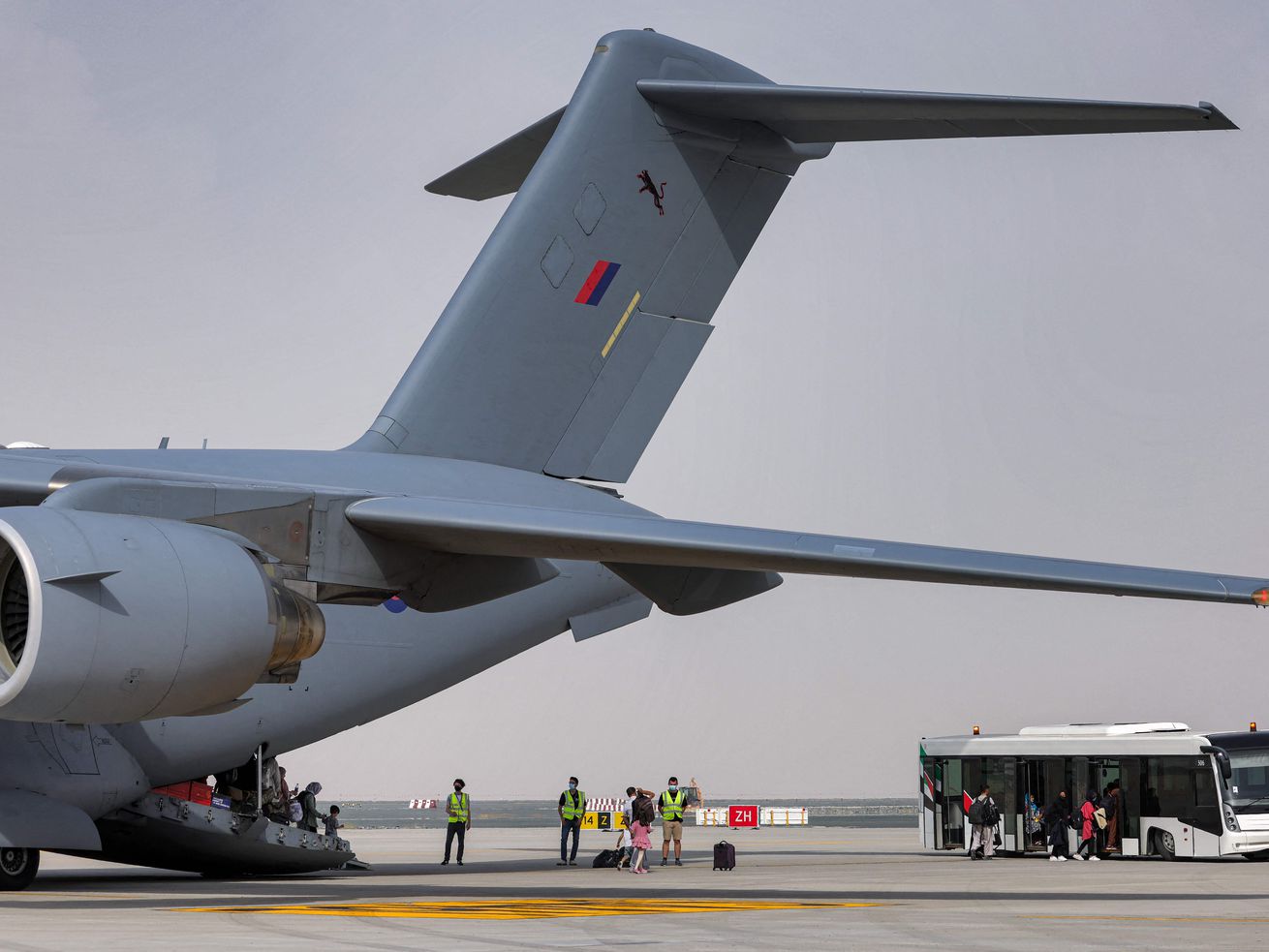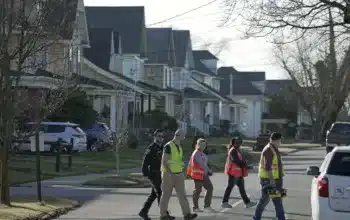Six US airlines will contribute to “one of the largest, most difficult airlifts in history.”
As the US evacuation from Kabul, Afghanistan, continues, Defense Secretary Lloyd Austin moved to activate the Civil Reserve Air Fleet on Sunday for just the third time in its history, calling up commercial aircraft to join the effort to transport evacuees.
The civilian fleet will not fly into Kabul’s airport directly, according to the Pentagon, but will instead be used to ferry evacuees onward “from temporary safe havens and interim staging bases” after they have been airlifted from Kabul.
“Activating CRAF increases passenger movement beyond organic capability and allows military aircraft to focus on operations in and out of Kabul,” the Pentagon said in a statement Sunday.
I’ve ordered @US_TRANSCOM to activate Stage I of the Civil Reserve Air Fleet. CRAF activation provides the @DeptofDefense access to commercial air mobility resources to augment our support to the @StateDept in the evacuation of Americans, SIV’s, and other at-risk Afghans. (1/3)
— Secretary of Defense Lloyd J. Austin III (@SecDef) August 22, 2021
The Wall Street Journal first reported that CRAF activation was under consideration by the Biden administration.
Currently, military aircraft — massive C-17 Globemaster III and C-130 Hercules planes — are being used to rescue thousands of US citizens, Afghan Special Immigrant Visa recipients, and “other at-risk individuals” from the country following the collapse of the US-backed government there earlier this month and ahead of the US troop withdrawal deadline of August 31.
The US is flying evacuees from Kabul to Doha, Qatar, where the US maintains an air base, and to a number of other countries, both in the region and further away.
“Bahrain, Denmark, Germany, Italy, Kazakhstan, Kuwait, Qatar, Tajikistan, Turkey, the UAE, the United Kingdom, and Uzbekistan have been, or will soon be, transiting Americans or, in some circumstances, others through their territories to safety,” State Department spokesman Ned Price said this week.
Some Afghan refugees have also been evacuated to the US; hundreds arrived in Annandale, Virginia, on Saturday night, and thousands more are expected to arrive in coming weeks.
“We have never seen this kind of increase in people wanting to volunteer,” Jacqueline Buzas, a program supervisor for a Texas refugee aid organization, told the Washington Post as communities in the US prepare to welcome Afghan refugees. “We have people calling to say, ‘I have an extra bedroom.’ Or, ‘I’m retired and have this extra house.’ People understand the human aspects of this, having to flee this life-or-death situation. And they just open the door.”
More than a dozen other countries, including the United Kingdom, France, and Germany, have also evacuated their citizens and Afghan nationals this week, according to Reuters.
The initial CRAF response will consist of 18 aircraft drawn from six different US-based passenger and cargo airlines, according to the Pentagon: American Airlines, Atlas Air, Delta Air Lines, and Omni Air will contribute three planes each, while Hawaiian Airlines will provide two and United Airlines four.
So far 18 planes across several U.S. airline and cargo carriers called up for the CRAF. United is sending 4 widebody 777-300s, which can carry just over 380 passengers each.
— Kathryn A. Wolfe (@kathrynwolfe) August 22, 2021
Capt. John Perkins, a spokesperson for the US Transportation Command, told the New York Times on Sunday that CRAF aircraft would begin operating on either Monday or Tuesday. In a Sunday statement, American Airlines said its aircraft would be “ready to deploy” by Monday.
“American is part of the CRAF program and is proud to fulfill its duty to help the U.S. military scale this humanitarian and diplomatic rescue mission,” the company said. “The images from Afghanistan are heartbreaking. The airline is proud and grateful of our pilots and flight attendants, who will be operating these trips to be a part of this life-saving effort.”
Previously, CRAF aircraft have been activated to assist US forces as part of Operations Desert Shield/Storm and Operation Iraqi Freedom, the Pentagon said. The program itself was established in 1951 by the Defense and Commerce departments in response to the Berlin airlift.
The decision to enlist civilian aircraft in the evacuation comes after a hectic week; Kabul fell to Taliban forces on August 15, and the US has deployed thousands of troops back into the country to help stabilize the airlift operation from Kabul’s Hamid Karzai International Airport.
As of Saturday, according to Maj. Gen. Hank Taylor, the US has about 5,800 troops on the ground and the airport “remains secure” as evacuation flights continue.
“In the last 24 hours, six US military C-17s and 32 charters departed Kabul,” Taylor said Saturday. “Through this combined effort, the total passenger count for those flights was approximately 3,800.”
At one point earlier in the week, a single US C-17 also evacuated 823 Afghans, including 183 children, setting an aircraft record for C-17s in the process.
CORRECTION: A @usairforce C-17 Globemaster III safely transported 823 Afghan citizens from Hamid Karzai International Airport Aug. 15, 2021. This is a record for this aircraft.⁰
The initial count of 640 inadvertently included only adults. 183 children were also aboard. https://t.co/DL6wP8WTQV— Air Mobility Command (@AirMobilityCmd) August 20, 2021
According to Defense One, which first reported the story,
The C-17, using the call sign Reach 871, was not intending to take on such a large load, but panicked Afghans who had been cleared to evacuate pulled themselves onto the C-17’s half-open ramp, one defense official said.
Instead of trying to force those refugees off the aircraft, “the crew made the decision to go,” a defense official told Defense One.
Within the last 24 hours, Secretary of State Antony Blinken said on Sunday, the US and coalition partners have evacuated almost “8,000 people on about 60 flights.” Since last Saturday, according to the White House, more than 25,000 people have been evacuated between US and coalition flights.
Latest Afghanistan evacuation figures from the White House: There have been approximately 25,100 personnel (on both military and coalitions flights) evacuated since August 14.
— Sebastian Smith (@SebastianAFP) August 22, 2021
However, there are tens of thousands more people who still need help: In a Wednesday interview, President Joe Biden told ABC News’s George Stephanopoulos that his administration estimated there were still between 50,000 and 65,000 Afghan allies of the US to be evacuated, including families.
“The threat is real”
As airlift efforts by US and coalition forces continue, safety concerns remain front of mind. In addition to a Taliban presence surrounding the Kabul airport, US officials have signaled that they are increasingly concerned about the possibility of an ISIS attack on the airport.
According to CNN, the Pentagon is worried that dense crowds around Kabul’s airport could become a target for ISIS or another terrorist group, using mortars, car bombs, or suicide bombers.
US concerns center specifically on a branch of ISIS, called ISIS-K or Islamic State Khorasan, that operates in Afghanistan and Pakistan, one US defense official told CNN. According to Biden, ISIS-K is a “sworn enemy” of the Taliban.
“The [ISIS] threat is real. It is acute. It is persistent. And it is something we’re focused on with every tool in our arsenal,” White House national security adviser Jake Sullivan told CNN on Sunday.
National Security Adviser Jake Sullivan says on CNN that the threat of a terrorist attack around the Kabul airport is “real” and “acute” pic.twitter.com/kOTObP3T9N
— Aaron Rupar (@atrupar) August 22, 2021
In response to the threat, the US began warning US citizens away from the airport on Saturday until directed otherwise.
“Because of potential security threats outside the gates at the Kabul airport, we are advising U.S. citizens to avoid traveling to the airport and to avoid airport gates at this time unless you receive individual instructions from a U.S. government representative to do so,” the US embassy in Afghanistan said in a security alert.
However, evacuations are continuing, Taylor said Saturday, with US commanders “metering how many people come in and out of the gate to ensure the [safety] and ability to screen applicants as they come.”
Desperate conditions at the Kabul airport
In addition to potential terror threats, conditions on the ground outside the Kabul airport remain chaotic, and at times deadly. At least seven people were killed in a stampede near the airport on Saturday, according to CNN correspondent Sam Kiley, and Austin told US lawmakers Friday that “some people, including Americans, have been harassed and even beaten by the Taliban.”
Senior international correspondent Sam @KileyCNN has arrived in Kabul – here is his report from the airport on @CNNSOTU pic.twitter.com/0S5lUZl9Mk
— Brian Stelter (@brianstelter) August 22, 2021
Harrowing personal stories — such as a baby who was lifted over razor wire by US Marines before being reunited with his father, or an Afghan interpreter for US special forces who finally made it to safety inside the airport after being beaten by the Taliban — have also emerged during the week.
Jalil and his family just made it inside the airport, after three attempts and massive coordination. People helping him are in tears. https://t.co/8bvZr9WN3s
— Monica Campbell (@monica_campbell) August 22, 2021
At points, US helicopters have been used to retrieve US citizens and Afghans in Kabul. According to the AP, a trio of Chinook helicopters flew 169 Americans from a nearby hotel to the airport because of safety concerns over traveling through a large crowd, while another helicopter ferried 96 Afghans to the airport for evacuation.
However, the US embassy in Kabul has warned “the U.S. government cannot ensure safe passage to the airport” — and some US flights have left the airport “nearly half empty,” according to the Pentagon, while the AP reports that one Belgian plane “took off empty because the people who were supposed to be aboard couldn’t get in.”
U.S. Air Force C-17 evacuation flights leaving Kabul airport nearly half empty: Pentagon
— Lucas Tomlinson (@LucasFoxNews) August 19, 2021
All told, there are believed to be anywhere from “several thousand” to 15,000 Americans still in Afghanistan, though the exact number remains unclear, and there are many thousands more Afghans hoping to escape the country.
As Vox’s Li Zhou reported earlier this week,
Already, roughly 88,000 Afghans are estimated to have applied for special immigrant visas (SIVs), an immigration channel open to individuals who worked with the US government as well as their family members. In addition to people pursuing SIVs, other Afghan residents are expected to apply for refugee status if they’re able to do so.
Earlier this week, the Pentagon announced that the US intends to resettle 22,000 Afghan SIV applicants in the coming weeks, though the number of people trying to leave is expected to be much larger.
Delays in the visa process, however — an issue that lawmakers and advocates raised well before the Taliban takeover this month — have also hindered evacuation efforts from the Kabul airport in some cases, with Afghan allies of the US stuck in a bureaucratic backlog.
“The past week has been heartbreaking,” Biden said in a Friday speech on the status of the US evacuation effort. “We’ve seen gut-wrenching images of panicked people acting out of sheer desperation. You know, it’s completely understandable. They’re frightened. They’re sad — uncertain what happens next.”
“I don’t think anyone — I don’t think any one of us can see those pictures and not feel that pain on a human level,” he said.
A looming deadline
As US and coalition evacuation efforts enter their second week after the fall of Kabul, the Biden administration is also facing down a deadline: August 31, the date Biden set in July to conclude the US military mission in Afghanistan.
On Wednesday, Biden told ABC that while the US is “gonna try to get it done before August 31,” it also won’t leave US citizens behind.
“If there’s American citizens left, we’re gonna stay to get them all out,” Biden said.
That could come with its own set of complications, however, including the need for the US to revisit its current arrangement with the Taliban, which ostensibly allows evacuations to go ahead without interference.
As of Thursday, Pentagon spokesperson John Kirby told reporters that “there has been no decision to change the deadline, and we are focused on doing everything we can inside that deadline to move as many people out as possible.
“If and when there’s a decision to change that, then obviously that would require additional conversations with the Taliban, as well,” he said, “but I don’t believe that those conversations have happened at this point.”
Biden administration officials have also expressed optimism that Sunday’s CRAF activation — as well as “agreements with more than two dozen countries on four continents” — can help expedite the evacuation process going forward, with Afghan immigrants going through background and security checks at various “staging points” outside of the US.
“We need more planes in the mix to do that piece of it, to move them from these initial points of landing on to places that they’ll ultimately resettle,” Blinken told CBS on Sunday.
Author: Cameron Peters
Read More



